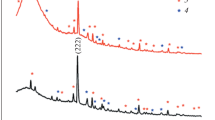Abstract
Antiferroelectric ceramic/polymer composites can be used as a base material in the future application of the tunable photonic crystals even high strain actuators, shock-activated energy transducer and high-density capacitor for their easy fabrication, good flexibility, precise control of the process parameters and good dielectric tenability affected by electric field. The adjustable dielectric effect in the antiferroelectric ceramic/polymer composites are experimentally studied with specific interest in the dependence on the inducing electric field up to 100 V/mm. The particulate composite consisting 20 vol% of polystyrene (PS), 80 vol% of lead barium lanthanum zirconium tin titanate (PBLZST) is fabricated by the means of solution mixing and hot pressing in lab. Scanning electron microscopy was used to investigate the morphology of the composites and the particle distribution, which shows that the nano carbon powders evenly dispersed in composite materials. It is observed that the addition of coupling agent and nano carbon powders influence the dielectric properties, such as the value of the tunability rate of dielectric permittivity and loss tangent. This is partly attributed to coupling agent improve two phase separation and enhanced the effect of ceramic phase in composites, and partly attributed to carbon powders which create electric paths between PBLZST Particles in composite material, which together make more electric field applied to ceramic phase and influence the response of dielectric permittivity controlled by electric field. As a result, the best electric field value to adjust the dielectric permittivity (ε) is 100 V/mm and maximum tunability rate was 49 %, with coupling agent at 10 wt% and nano carbon powders at 1 wt% in composites.







Similar content being viewed by others
References
S.U. Adikary, Compos. Sci. Technol. 62, 2161–2167 (2002)
Y. Bai, Z.Y. Cheng, Q.M. Zhang, Appl. Phys. Lett. 76, 3804–3806 (2000)
S.K. Bhattacharya, R.R. Tummala, Microelectron. J. 32, 11–19 (2001)
Z.M. Dang, Y.H. Lin, C.W. Nan, Adv. Mater. 15, 1625–1629 (2003)
Z.M. Dang, L.Z. Fan, C.W. Nan, Mater. Sci. Eng. B 103, 140–144 (2003)
K. Dong Hau, C. Chie Chih, S. Yeu, Mater. Chem. Phys. 85, 201–206 (2004)
A. Figotin, Y.A. Godin, Phys. Rev. B 57, 2841–2848 (1998)
T. Joseph, S. Uma, J. Philip, M.T. Sebastian, J. Mater. Sci. Mater. Electron. 23, 1243–1254 (2012)
A.Z. Khokhar, R.M.D.L. Rue, K. Ren, Z.Y. Li, J. Opt. A Pure Appl. 9, 446–450 (2007)
K.H. Lam, H.L.W. Chan, Microelectron. Eng. 66, 792–797 (2003)
B. Li, J. Zhou, L.T. Li, Appl. Phys. Lett. 83, 4704–4706 (2003)
K. Lichtenecker, Phys. Z. 25, 225 (1994)
R.H. Lyddane, R.G. Sachs, E. Tellers, Phys. Rev. 59, 673–676 (1941)
B. Ma, R. Zuo, J. Yu, Y. Ran, H.W. Wang, L.W. Chan, J. Mater. Sci. Mater. Electron. 22, 1697–1702 (2011)
Y. Rao, S. Ogitani, C.P. Wong, J. Appl. Polym. Sci. 83, 1084–1090 (2002)
Y. Rao, A. Takahashi, C.P. Wong, Compos. A 34, 1113–1116 (2003)
R.E. Service, Science 1997, 275 (1878)
X.X. Wang, K.H. Lam, X.G. Tang, H.L.W. Chan, Solid State Commun. 130, 695–699 (2004)
Q. Wang, S. Jiang, Y. Zhang, G. Zhang, L. Xiong, J. Mater. Sci. Mater. Electron. 22, 849–853 (2011)
C.K. Wong, F.G. Shin, J. Mater. Sci. 41, 229–249 (2006)
P. Yang, A.P. David, J. Appl. Phys. 71, 1361–1367 (1992)
H. Yang, H. Wang, F. Xiang, X. Yao, J. Electroceram. 22, 221–226 (2009)
Q.M. Zhang, H.F. Li, M. Poh, F. Xia, Z.Y. Cheng, H.S. Xu, C. Huang, Nature 419, 284 (2002)
Y. Zhang, E. Wang, H. Li, Y. Cai, J. Zhang, J. Mater. Sci. Mater. Electron. 26, 37–41 (2015)
J. Zhou, C.Q. Sun, K. Pita, Appl. Phys. Lett. 78, 661–663 (2001)
Acknowledgments
The present study was supported by “the Fundamental Research Funds for the Central Universities” (2013ZZGH014), National Science and Technology Support Program (2012BA113B00), National Nature Science Foundation of China (51102102, 61378076). We acknowledge Analytical and Testing Center of Huazhong University of Science and Technology for characterizations of our samples.
Author information
Authors and Affiliations
Corresponding authors
Rights and permissions
About this article
Cite this article
Pei, C., Jiang, S., Yu, Y. et al. Effect of electric field on dielectric properties of antiferroelectric ceramic/polymer composites. J Mater Sci: Mater Electron 26, 3236–3242 (2015). https://doi.org/10.1007/s10854-015-2822-9
Received:
Accepted:
Published:
Issue Date:
DOI: https://doi.org/10.1007/s10854-015-2822-9




